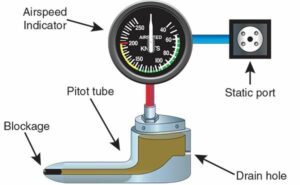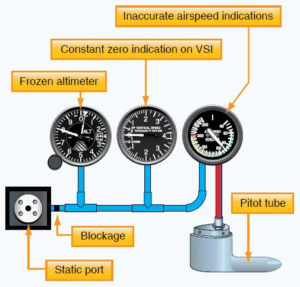Blog
Pitot-Static System Errors
- September 9, 2024
- Posted by: rsadmin_user
- Category: Education

Pitot-Static System Errors
Blocked Pitot Tube Errors
A fully blocked pitot tube will result in an airspeed over-read during a climb and an under-read during a descent. This occurs because the static port becomes the sole source of information, causing the pitot tube to function similarly to an altimeter.
With a partially blocked pitot tube, the indicated airspeed will be inaccurate, falling somewhere between zero and the actual airspeed.
The static port instruments will continue to operate normally in this case.
Blocked Static Port Errors
A blocked static port will affect all three related instruments (Airspeed Indicator, Altimeter, Vertical Speed Indicator).
- The Altimeter will freeze at the last recorded altitude.
- The Vertical Speed Indicator will remain at zero.
- The Airspeed Indicator will under-read during climbs and over-read during descents.
Memory Aid
Remember that if the static port is the only source of information for the Airspeed Indicator (ASI), it will behave like an altimeter. The ASI measures dynamic pressure (which varies with airspeed) and subtracts the static pressure to determine the airspeed.
Read Bonus Article:
Flight instruments have undergone significant advancements, evolving from basic yaw strings to sophisticated pitot-static systems. Modern pitot-static systems provide critical data to aircraft computers, including airspeed, altitude, and vertical speed.
Experiencing a malfunction in the pitot-static system during flight is a serious safety concern, as it jeopardizes the safety of everyone on board. This guide explains how a typical pitot-static system operates and the potential effects of system errors. Additionally, we provide a tailored equation to troubleshoot and identify various failure modes.
Lessons Learned
A Simple Oversight with Severe Consequences
A maintenance worker applied tape to the static port(s) to clean the aircraft exterior but forgot to remove it before takeoff. The aircraft departed with a blocked static port, leading to erroneous readings on Aeroperú Flight 603’s airspeed indicator, altimeter, and vertical speed indicator. The aircraft lost altitude undetected by the pilots and tragically crashed into the sea, resulting in the loss of all 70 lives on board.
A Fatal Insect Nest
On Birgenair Flight 301, a wasp nest obstructed the captain’s pitot tube, causing erroneous airspeed indications. This led to a stall and crash into the Atlantic Ocean, resulting in the deaths of 189 passengers.
Pitot-Static System and Potential Errors
A typical pitot-static system consists of two pitot tubes, two static ports (with an alternate static source), and the associated instruments: airspeed indicator, altimeter, and vertical speed indicator.
While relatively simple, this vital system can be prone to errors, often related to blockages. Understanding the potential failure modes and how to diagnose them is crucial.
Overview of the Pitot-Static System
- Airspeed Indicator: Receives inputs from the pitot tube.
- Altitude and Vertical Speed Indicators: Receive inputs from the static ports only.
Pitot Tube Functionality
- Main Intake Blockage: Prevents ram air from entering the tube, causing the airspeed indicator to show zero.
- Drain Hole Blockage: May result in inaccurate airspeed readings due to trapped water.
- Combined Blockages: Causes the airspeed indicator to act like an altimeter, showing erroneous readings based on altitude changes.
Mitigating Pitot Tube Blockages
Activating the pitot heat can prevent ice formation, which is a common cause of blockage. However, it will not resolve issues caused by physical obstructions like nests or covers.
Static Port Blockage
A blocked static port affects all three related instruments:
- Airspeed Indicator: Under-reads during climbs and over-reads during descents.
- Altimeter: Freezes at the last recorded altitude.
- Vertical Speed Indicator: Remains at zero.
Addressing Static Port Blockages
An alternate static source located within the cabin can be used when the external static port is blocked. Pilots should switch to this source using the cockpit toggle switch and adjust airspeed readings based on the flight manual’s calibration chart.
Final Thoughts
The pitot-static system is crucial for accurate flight instrument readings. Malfunctions in this system can lead to serious errors in altimeter, airspeed, and vertical speed indicators. Understanding how these errors manifest and how to troubleshoot them is essential for maintaining flight safety.
4o mini
